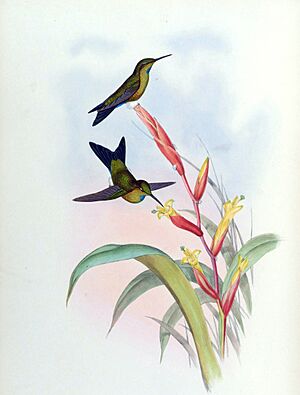Turquoise-throated puffleg facts for kids
Quick facts for kids Turquoise-throated puffleg |
|
|---|---|
 |
|
| Conservation status | |
| Scientific classification | |
 |
The turquoise-throated puffleg (Eriocnemis godini) is a tiny hummingbird from Ecuador. It is also known as Godin's puffleg. This bird is mostly green. It has blue feathers under its tail. Its legs have fluffy white feathers, like little powder-puffs! Male birds have a special bluish-purple patch on their throat.
Scientists only know about this bird from a few examples found long ago. These examples were collected in the 1800s. The places where this bird used to live have mostly disappeared. Recent searches for this hummingbird have not found any. The International Union for Conservation of Nature thinks it might be extinct. However, there's a small chance some are still alive. Because of this, it is listed as "critically endangered".
Contents
What Does the Turquoise-Throated Puffleg Look Like?
Based on the few birds scientists have seen, this hummingbird is about 10 to 11 centimeters long. That's about the length of your hand!
The male bird's plumage (feathers) are mostly a shiny golden-green. Its throat has a bright turquoise color. The feathers on its lower back and upper tail are bluish-green. Its tail is forked and bluish-black. Both male and female birds have violet-blue feathers under their tails. They also have a straight, black beak.
Female birds look a bit different. They do not have the bright throat patch. Their feathers are not as shiny. Their belly feathers are more golden. Like all puffleg hummingbirds, they have those amazing fluffy white feathers on their legs. These look like little balls of cotton!
Why Is This Hummingbird a Mystery?
The turquoise-throated puffleg is a bit of a puzzle for scientists. This is partly because so few birds have ever been found. Some scientists, like Graves (1996), think it might be a hybrid. This means it could be a mix of two different Eriocnemis hummingbird species.
Other scientists, like Ridgely (2001), believe it might just be a subspecies. A subspecies is a group within a species that has small differences. They think it could be a subspecies of the E. vestita hummingbird. This debate makes the bird even more interesting!
Where Did This Hummingbird Live and Why Is It Endangered?
Scientists only know about six of these hummingbirds. All of them were collected in the 1800s. Only one of these birds has a known location. It was found in the Chillo valley in Guayllabamba, Ecuador. This was in an area about 2,100 to 2,300 meters high.
Two other bird skins were simply labeled "Bogotá". In the 1800s, this was a common way to label birds. It did not always mean the bird was actually found in Bogotá, Colombia. Some people think these two birds might have come from Pasto, Colombia.
Sadly, almost all the places where this hummingbird might have lived are gone. People have built on the land or changed it. Only small parts of its old home are left.
Scientists tried to find this bird again in 1976 and 1980. But they were not successful. This is why it is so important to protect the few natural areas that are left.
See also


